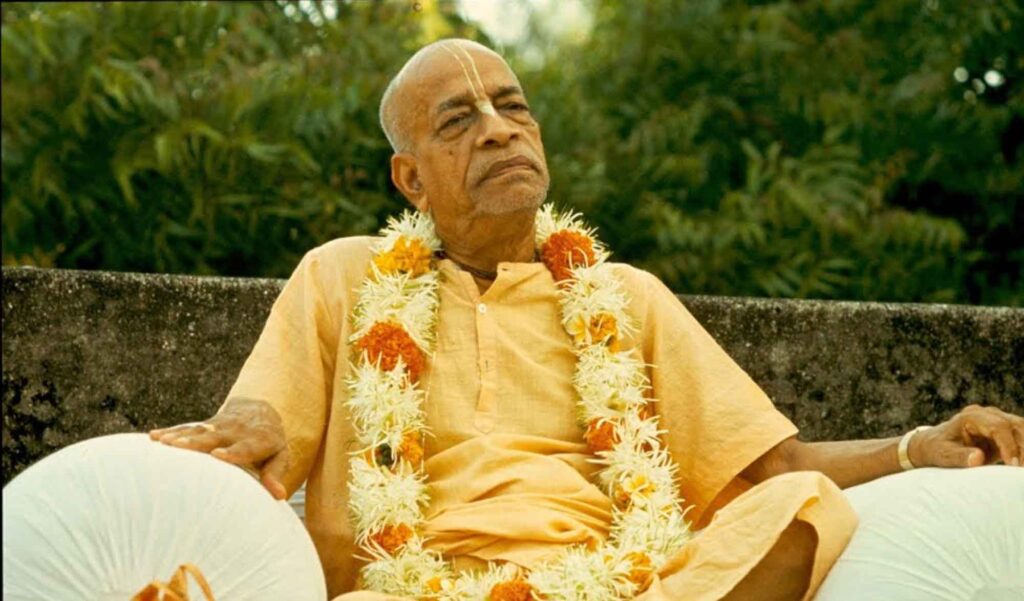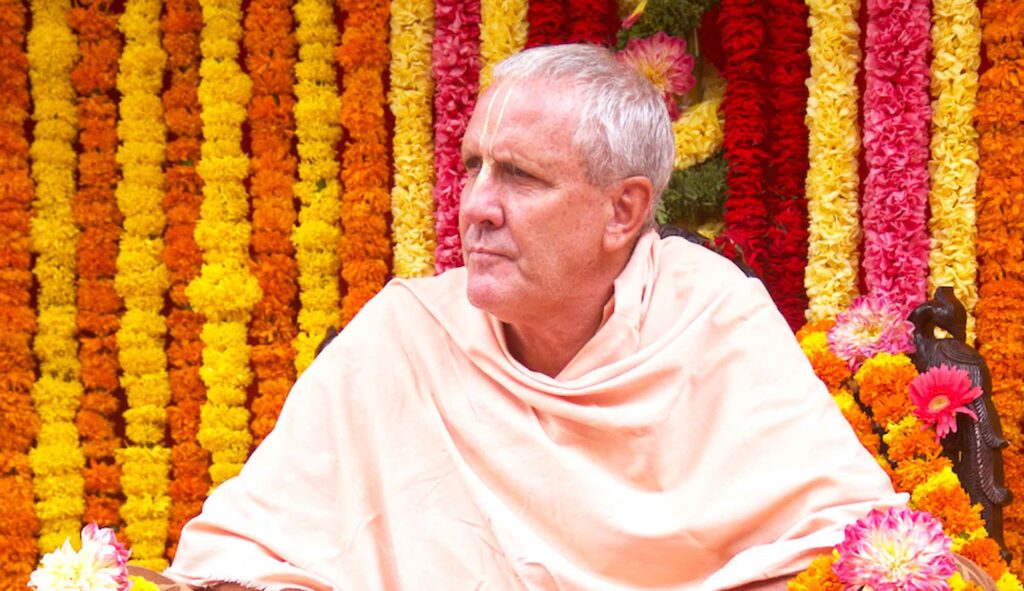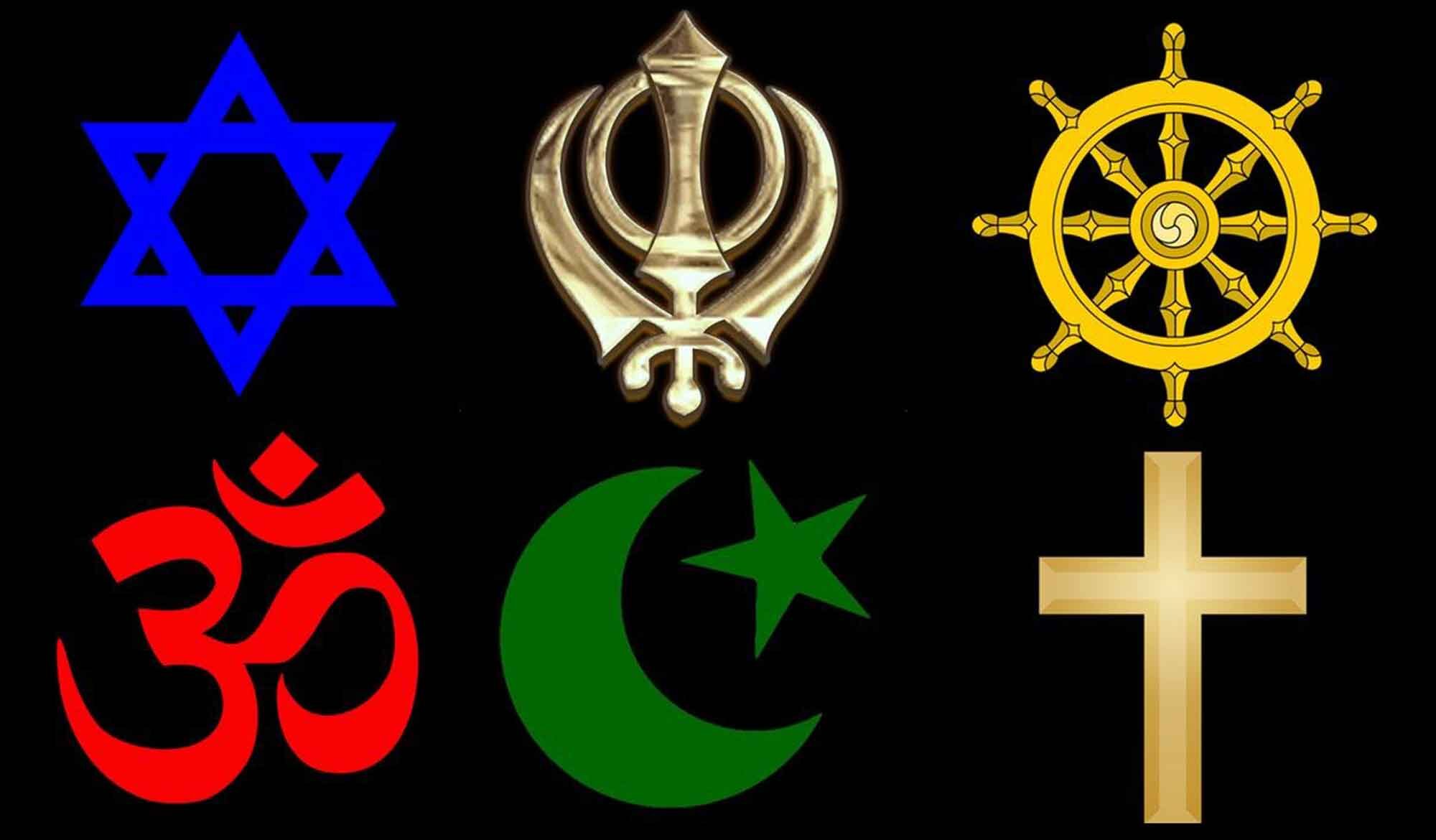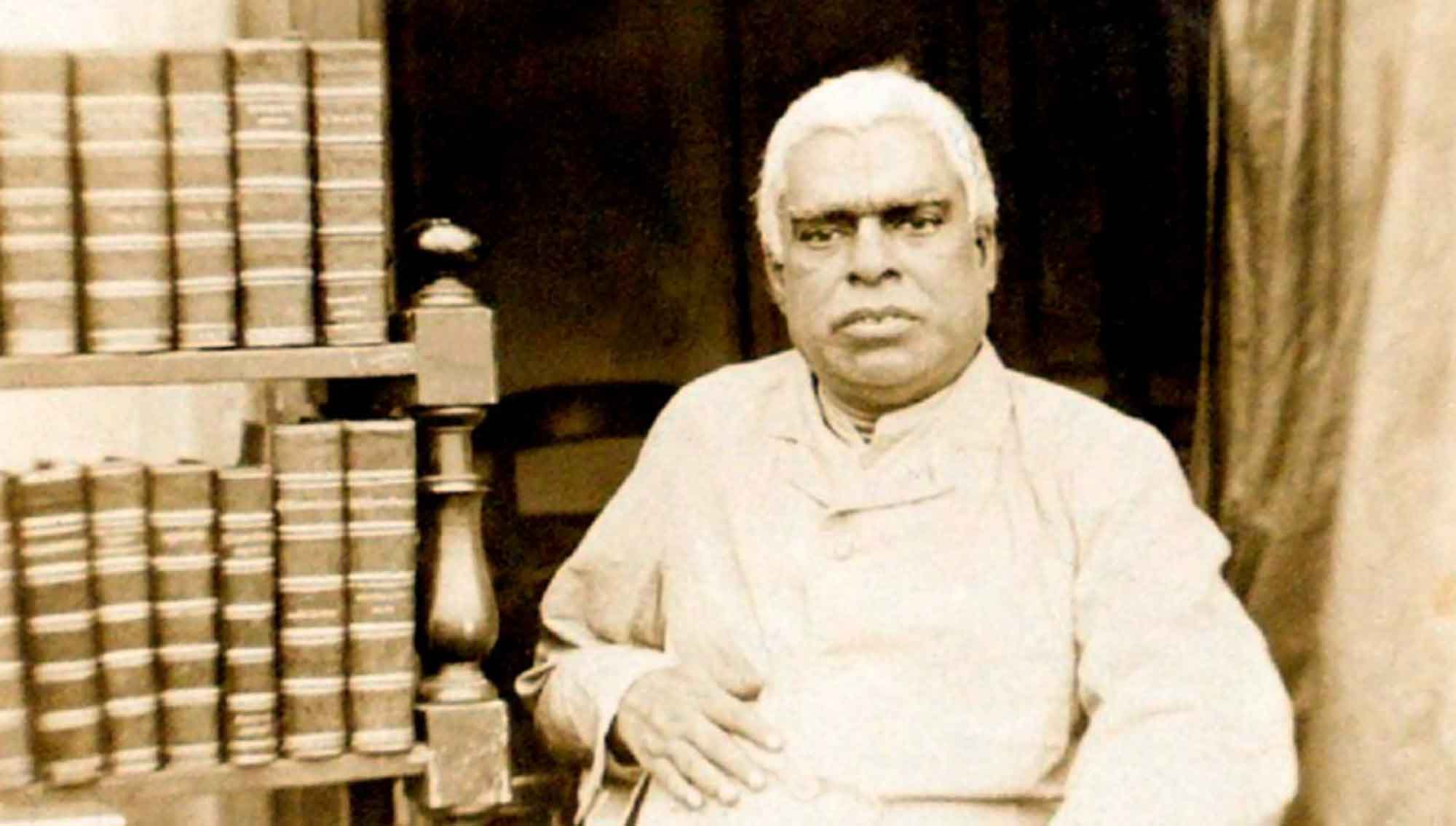by Swami B.G. Narasingha
The following is a Vyāsa Puja offering to His Divine Grace Śrīla A.C. Bhaktivedānta Swami Prabhupāda, written by Swami B.G. Narasingha (Jagat-Guru Swami) in 1987. In this offering Swami Narasingha explains the evolution of Śrīla Prabhupāda's name.
The Spiritual Evolution of the Name “His Divine Grace A.C. Bhaktivedānta Swami Prabhupāda”
Each and every syllable of the transcendental name of our beloved spiritual master and eternal father brings joy and gladness to our heart. We are full of transcendental pride about the name of our Guru Mahārāja, and therefore we would like to share the nectar of the evolution of that name with all those who adore the lotus feet of our divine master on the auspicious day of his appearance in this world.
Śrīla Prabhupāda was born a pure devotee of Lord Kṛṣṇa, and this fact is accepted far and wide. Not only was he born a pure devotee, but he was also born in the family of pure devotees. Śrīla Prabhupāda writes in the dedication of the Kṛṣṇa book, “To my father, Gaura Mohana De (1849-1930), a pure devotee of Kṛṣṇa….”
When Śrīla Prabhupāda was born, his father named him Abhaya Caraṇa. Abhaya Caraṇa means “one who is fearless, having taken shelter at the lotus feet of Kṛṣṇa.” Śrīla Prabhupāda ’s uncle called him Nandulāla because he was born on Nandotsava, the day Kṛṣṇa’s father observed Kṛṣṇa’s birth ceremony. But that was not the choice of his father, and thus Prabhupāda was named Abhaya Caraṇa De.
Later in his childhood, the family gave Śrīla Prabhupāda the nickname ‘Kacori-mukhi’ because of his great liking for kacoris. That, though, was only a nickname for his childish behaviour, and he soon left that name behind.
When Śrīla Prabhupāda, as a grown man, was initiated by Śrīla Bhaktisiddhānta Sarasvatī Ṭhākura in 1933, Śrīla Bhaktisiddhānta changed his name from Abhaya Carana to Abhaya Caraṇāravinda. The word caraṇāravinda conveys a more developed concept of the word caraṇa, or surrendered at the lotus feet.” Thus Bhaktisiddhānta acknowledged the purity of Śrīla Prabhupāda’s father when he said, “His father has already named him.” Śrīla Prabhupāda once wrote about his father, “He was kind to me, and I imbibed from him the ideas later on solidified by my spiritual master, the eternal father.”
After his initiation, Śrīla Prabhupāda became known to his godbrothers as Abhaya Bābu. Some years later, after the disappearance of Śrīla Bhaktisiddhānta, a sannyāsī godbrother, Bhakti Sāraṅga Mahārāja, conferred a title of distinction upon Śrīla Prabhupāda for his exalted service. It is very surprising at this point to learn that Śrīla Prabhupāda received the title Bhaktisiddhānta, the very name of his guru.
In this regard one may refer to the League of Devotees registration papers kept in the BBT archives. There one can see in Śrīla Prabhupāda’s own handwriting, “Alias A.C. Bhaktisiddhānta Dāsa Adhikārī.” In the League of Devotees’ papers this appears three times in Śrīla Prabhupāda’s own handwriting.
This happened sometime in 1953, and for a period of three or so months Śrīla Prabhupāda was known as A.C. Bhaktisiddhānta Dāsa Adhikārī. Then there were some complaints from the godbrothers. These complaints were not directed at Śrīla Prabhupāda, but out of loving sentiment, some thought that no one should be given the name Bhaktisiddhānta. That name or title should be held as most sacred.
However, it was agreed that Śrīla Prabhupāda should have a title of distinction due to his advanced qualifications in devotional service. At that time the godbrothers met, and a particular godbrother, who was very dear to Śrīla Prabhupāda and respected by all the branches of the Gauḍīya Maṭha, chose the name Bhaktivedānta, which was then conferred upon Śrīla Prabhupāda. Generally, it is known that the Gauḍīya Maṭha gave Śrīla Prabhupāda the distinguished title Bhaktivedānta, but few devotees actually know that the dear associate who chose the name for our beloved spiritual master was Swami B.R. Śrīdhara Mahārāja of Navadvīpa-dhāma.
Śrīla Prabhupāda then became known respectfully as A.C. Bhaktivedānta Prabhu, or just A.C. Bhaktivedānta. By 1959 Śrīla Prabhupāda was destined by the transcendental arrangement of the Lord to take sannyāsa, the renounced order of life. On September 17, 1959, Śrīla Prabhupāda accepted the renounced order of life from another dear godbrother, Bhakti Prajñāna Keśava Mahārāja. At that time Śrīla Prabhupāda received the title and name Swami Mahārāja. This name Swami Mahārāja was one of the 108 names for sannyāsīs chosen by Śrīla Bhaktisiddhānta Sarasvatī Ṭhākura.
All the time of Śrīla Prabhupāda’s sannyāsa there was also a godbrother present named Sanātana Prabhu, who also accepted sannyāsa. Sanātana Prabhu’s name became Bhaktivedānta Muni Mahārāja. It so happened, that from 1953 onwards, many members of the Gauḍīya Maṭha received the title Bhaktivedānta and that tradition still continues down to the present day. Therefore, to distinguish amongst the Bhaktivedāntas, they are known amongst one another by their sannyāsa names, such as Muni Mahārāja, Nārāyaṇa Mahārāja, Vāmana Mahārāja, etc. Śrīla Prabhupāda, as a sannyāsī, is known to his godbrothers as Swami Mahārāja.
Śrīla Prabhupāda soon began his translation and purports of Śrīmad Bhāgavatam, entitled the ‘Bhaktivedānta Purports.’ With the name Bhaktivedānta, our divine master came to the West to fulfil the words of Lord Caitanya Mahaprabhu and the desires of Śrīla Bhaktisiddhānta Sarasvatī Ṭhākura by spreading Kṛṣṇa consciousness to every town and village in the world.
But to those to whom he came, to those who loved him, he was known affectionately as ‘Swamiji.’ Of course, this is not really a proper title for one’s spiritual master. But they were young and without any Vaiṣṇava culture, and so out of his ocean of kindness Śrīla Prabhupāda accepted. Then one day a devotee – and I don’t know who, but whoever he is I bow at his feet – asked Śrīla Prabhupāda if there was any special way of addressing the spiritual master with affection, and Śrīla Prabhupāda replied, “Yes. You may call the spiritual master Prabhupāda.”
And a happy day for all of us to have the full-fledged mercy of our eternal spiritual master. Soon, “His Divine Grace” was added, and thus the name His Divine Grace A.C. Bhaktivedānta Swami Prabhupāda came to be, by the grace of Kṛṣṇa. A happy day for us, but not for all. When Śrīla Prabhupāda returned to India, many of his godbrothers resented that he was being called Prabhupāda. At that time the same godbrother who had given Prabhupāda the name Bhaktivedānta and whom Śrīla Prabhupāda loved dearly came forward and defended our spiritual master. He proclaimed that he was “fit to be called Prabhupāda.” He was the most confidential devotee of the Lord, he was empowered to preach Kṛṣṇa consciousness all over the world, he was the shelter of tens of thousands of Vaiṣṇavas, he was ‘Prabhupāda.’
When referring to or addressing Prabhupāda, the devotees also began to say ‘Śrīla,’ thus giving the highest respect as well as affection. All glories to His Divine Grace A.C. Bhaktivedānta Swami Prabhupāda, by whose grace we are engaged in the eternal service to the divine couple Sri Sri Radha-Govinda! All glories to our divine master! All glories to his transcendental appearance in this world to deliver the fallen souls!
My dear master, by chanting your transcendental name and singing your transcendental glories, sins go far away. All glories to you, Śrīla Prabhupāda! You are an ocean of nectar and the deliverer of your sincere devotees. I take shelter at your lotus feet.
namaḥ oṁ viṣṇu-pādāya kṛṣṇa-preṣṭhāya bhūtale
svāmī śrī bhaktivedānta prabhupādāya te namaḥ
gurvājñāṁ śīrasi-dhāryam śaktyāveśa sva-rūpiṇe
hare-kṛṣṇeti mantreṇa pācātya-prācya-tāriṇe
viśvācārya pra-varyāya divya kāruṇya mūrtaye
śrī bhāgavata-mādhurya-gītā-jñāna-pradāyine
gaura śrī-rūpa-siddhānta-sarasvatī niṣeviṇe
rādhā-kṛṣṇa-padāmbhoja-bhṛṅgāya gurave namaḥ
“I offer my humble obeisances unto His Divine A.C. Bhaktivedānta Swami Prabhupāda, who is very dear to Lord Kṛṣṇa on this earth, having taken shelter at His lotus feet. Taking the order of his guru on his head, he became empowered by Nityānanda Prabhu to act as a śaktyāveśa-avatāra. He distributed the Hare Kṛṣṇa mantra all over the Eastern and Western worlds, delivering and uplifting all fallen souls. He is the best of millions of jagad-gurus, because he is the personification of divine mercy. He has distributed the sweet nectar of Śrīmad Bhāgavatam and the transcendental knowledge of Bhagavad-gītā all over the world. He is constantly engaged in exclusive devotional service to Śrīla Bhaktisiddhānta Sarasvatī Ṭhākura, Śrīla Rūpa Gosvāmī, and Śrī Gaurāṅga Mahāprabhu. I offer my humble obeisances unto Śrīla Prabhupāda, who is like a bumblebee always tasting the nectar of the lotus feet of Śrī Śrī Rādhā and Govinda.”
Your eternal servant,
Jagat-Guru Swami
More Articles by Swami B.G. Narasingha
Real Religion is not Man-made
"Real Religion is not Man-made" was written by Swami B.G. Narasingha on September 8th 2006. Narasingha Maharaja discusses the concepts of śraddhā and śaraṇāgati in relation to Vaiṣṇavism and other world religions.
The Sacred River Sindhu/Indus
‘The Sacred River Sindhu/Indus’ was posted by Swami B.G. Narasingha on his blog, narasingha.net, on October 2nd, 2011. In this short article, Narasingha Maharaja explains the significance of the River Sindhu and his pilgrimage to it. This article was later expanded into a bigger article called ‘Sindhu River – How India Got Her Name.’
Scholarship vs Divine Revelation
‘Scholarship vs Divine Revelation’ was first written by Swami B.G. Narasingha in December 2002. In this article Narasingha Maharaja defends the reputation of Śrīla Bhaktivinoda Ṭhākura from a scholar who claims that some of the works of the Ṭhākura are ‘pious forgeries.’













